
Steam Boiler
A boiler or steam generator is a device used to create steam by applying heat energy to water. Although…
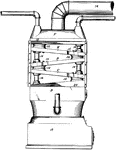
Hot Water Heater
Water heating is a thermodynamic process using an energy source to heat water above its initial temperature.…
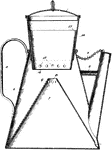
Original Type Coffee Pot
This coffee pot contains a bottom chamber which contains water. When this is heated, pressure from the…
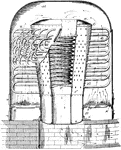
Steam Boiler Engine
This design with natural induction used for marine purposes was the popular “Scotch” marine boiler,…
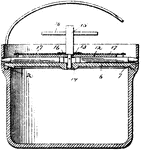
Steam and Water Cooker
Pressure cooking is a method of cooking in a sealed vessel that does not permit air or liquids to escape…

Mechanical Drawing Cross Hatching of Material Symbols
"The illustration gives conventions for a number of different materials. Those in the first line are…

Traction Engine Steering Device
A traction engine is a self propelled steam engine used to move heavy loads on roads, plough ground…

Centrifugal Creamer
This centrifugal creamer is a machine used to separate cream through a steam power source which helps…

Steam Cooking Vessel
A slow cooker consists of a lidded round or oval cooking pot made of glazed ceramic or porcelain, surrounded…

Steam Cooking Utensil
A food steamer or steam cooker is a kitchen appliance used to prepare various foods in a sealed vessel…

Iron Duke Class British Battleship
A 1912 British navy battleship Iron Duke class. Battleships in this class is operated by steam and have…

British Navy Queen Elizabeth Class Battleship
The Queen Elizabeth class of 1912 powered by steam. The battle ship have two chimney stacks to burn…

British Royal Navy D Class Torpedo Boat Destroyer
British Royal Navy's D class Torpedo Boat Destroyers (TBDs) launched in 1918. The ship had 12 guns,…

British Royal Navy H.M.S. Erebus Battleship
British Royal Navy battleship, H.M.S. Erebus. The ship was completed in 1870, at Napier shipyard as…

United States Navy Omaha Class Battlecruiser
A U.S. Navy Omaha class battlecruiser launched in 1920. The top speed of the cruiser is 35 knots (40…

Rotary Water Heater
Water heating is a thermodynamic process using an energy source to heat water above its initial temperature.…

Two Vessels from Thomas Savery First Steam Engine
Two vessels from the Thomas Savery first steam engine. The right tank fills up with water while the…
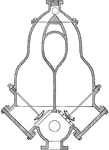
Pulsometer from Steam Engine
"A modification of Savery's engine, the pulsometer, is still quite common. It is used in places where…
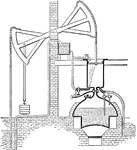
Newcomen Atmospheric Steam Engine
An illustration of Newcomen atmospheric steam engine. The boiler heats the water to build up steam in…
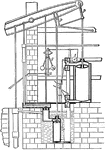
Watt's Final Steam Engine Design
The illustration showing Watt's final steam engine design. The engine is fitted with series of rods…
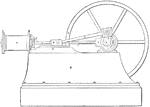
Low Power Simple Steam Engine Diagram
A low power steam engine. The piston inside cylinder A moves the wheel, generating power at 100 horsepower…

Low Power Simple Expansion Steam Engine
A low power simple expansion steam engine. The steam engine can run at 100 horsepower, and not run continuously.…

Cross Compound Steam Engine
Illustration of a cross compound steam engine. The engine is designed to hold pressure until the engine's…
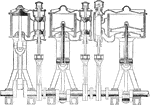
Piston of a Triple Expansion Steam Engine
A piston diagram from a triple expansion steam engine. The three cylinders are designed at high, medium,…
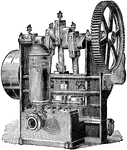
Power Pump Steam Engine
A power pump steam engine without shaft. The engine turns the wheel with the reciprocal motion of the…
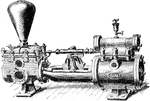
Direct Acting Steam Pump
"The direct—acting steam pump has the steam piston at one end of a rod and the water position…

Steam Engine Condenser with Pumps
An illustration of the water entering and exiting the condenser through pump. The cooling water enters…
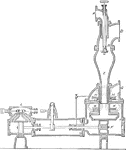
Steam Engine Jet Condenser with Pump
A sliced view of a jet condenser with pump. The steam enters at D, while cold water enters at A. The…

Application of Steam Engine Jet Condenser used to Pump Well Water
An illustration showing the application of a jet condenser to pump a well. The steam enters the engine…
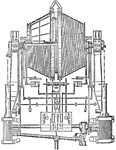
Plan of Direct Acting Hoisting Machine with Corliss Steam Engines for Mining
A plan of direct acting hoisting machine for mining industry. The machine is operated by compound Corliss…

Water Tower Condenser Steam Cooling System in Engine Room
A diagram illustrating cooling steam exhaust of steam engine using a water tower. The water is pumped…
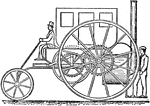
Side View of 1802 Trevithick Steam Carriage
The side view of 1802 Trevithick's Steam Carriage. This horseless carriage is operated by a steam engine…

Plan of 1802 Trevithick Steam Carriage
A mechanical plan of 1802 Trevithick's Steam Carriage. The piston, operated by steam, is connected to…
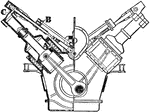
Bentley Eight Cylinder Diagonal Tandem Compound Superheated Steam Engine for Tractor
A eight cylinder Bentley superheated steam engine fitted to a tractor. The steam is used to move the…

Sheppee Motor Company Compact Double Acting SUperheated Engine
"In this engine the cam—shaft by which the steam and exhaust valves are operated is situated midway…
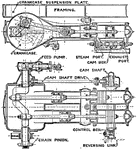
Twin Cylinder Steam Engine Fitted to Sentinel Wagons
Illustration showing a twin cylinder steam engine fitted to a sentinel wagon. The steam expands and…
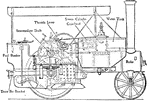
Side and Inside View of Steam Operated Vehicle
A side and inside view of the superheated steam vehicle. Water is heated by a heat transferred by the…
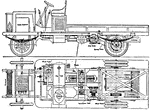
Steam Operated Tractor with Outside Spring Suspension
A tractor compound steam engine with outside suspension spring. The spring suspension helps stabilize…

Steam Operated Wagon with Transmission Gearing with Double Helical Gear
A steam operated wagon with two speed gear. The gears are located at the intermediate shaft, moving…

Wagon with Steam Engine and Transmission Gearing with Double Helical Gear
"The transmission on the first type of vehicle is by means of gearing throughout, and is completely…

Steam Wagon with Two Side Chains Transmitting Drive
An illustration of a steam wagon with a transmission with two side chains. The boiler is located on…

Steam Wagon with Single Chain Transmitting Drive
A steam wagon with single chain, connecting the back wheels to the differential gear. The engine is…

Yorkshire Steam Wagon Patent
A Yorkshire steam wagon patent with unique boiler construction. The wagon operates with the drive chain…

Yorkshire Steam Wagon Transverse Boiler
A Yorkshire steam wagon transverse boiler. Water is continuously enters the large cylindrical container.…

Colonel Crompton's Superheated Steam Tractor
A superheated steam tractor built by Colonel Crompton. The boiler, located in the front, heats the water,…
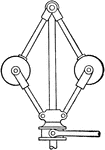
Governor with the Balls Connected to the Base for Steam Engine
A spindle governor where both balls are connected to the base. The governor is used to regulate the…
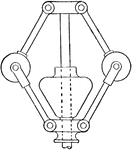
Spring Governor for Steam Engines
"This type of governor is used frequently on throttling engines; it consists of a pendulum governor…
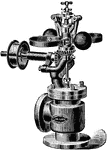
Exterior View of Waters Spring Governor
An exterior view of a waters spring governor. The governor is used to regulate fuel by closing and opening…
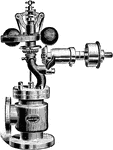
Waters Spring Governor with Safety Stop
"In this goveror the weights are always in the same plane, the variation in height being due to the…
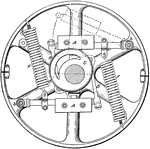
Buckeye Engine Governor
"A wheel which contains and supports the various parts of the governor is keyed to the shaft. Two arms,…
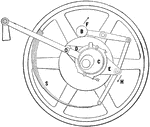
Straight Line Engine Governor
A straight line engine governor illustrating the direction of the ball (B) is going. The single ball…
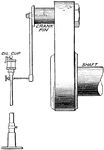
Belt Drive Oiling Apparatus
An apparatus used to oil the crank pin of the belt drive system. The oil cup is filled with lubricant…
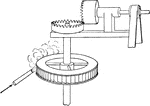
Steam Rotary Engine
An illustration of a rotary steam engine. The steam turbine system was invented by Branca in 1629. Steam…
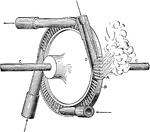
De Laval Steam Turbine
A De Laval steam turbine. The turbine is operated by supplying steam into the four nozzles. The steam…

De Laval Steam Turbine Connected to Generator
A De Laval steam turbine connected to a generator. The turbine generates electricity by turning the…

Pearsons Turbine for Electricity Generator
A cross sectional view of the Pearsons turbine for generating electricity. The turbines, located in…
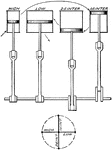
Quadruple Expansion Engine Piston
A piston system from a quadruple expansion engine showing the movement of steam. Steam first enters…

Jacketing Piston to Reduce Heat Loss
"The cylinder covers are also made hollow to permit a circulation of live steam. A cylinder having the…
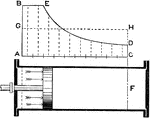
Watt's Work Indicator Diagram
A Watt's work diagram, or indicator diagram, for steam pressure in cylinder. The graph (top) illustrates…
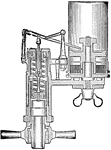
Thompson Indicator for Steam Engine
"The indicator consists of a cylinder in which a piston is fitted, a spring, multiplying lever, and…